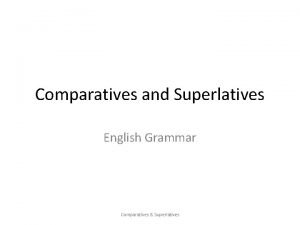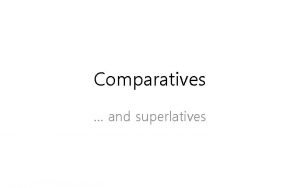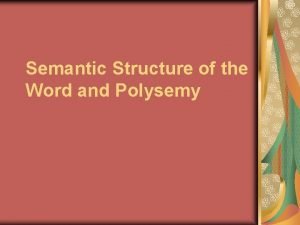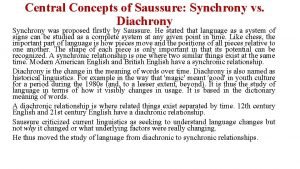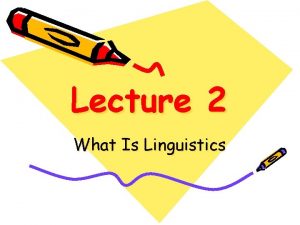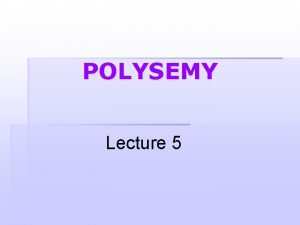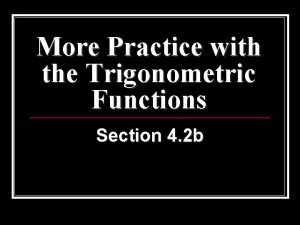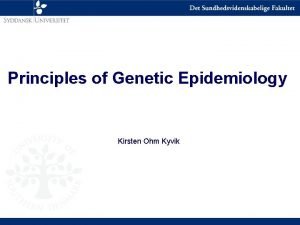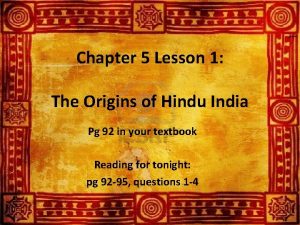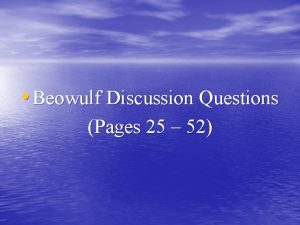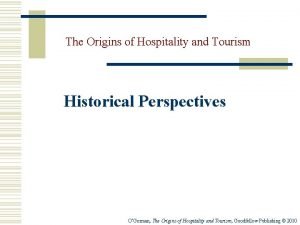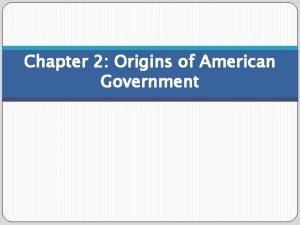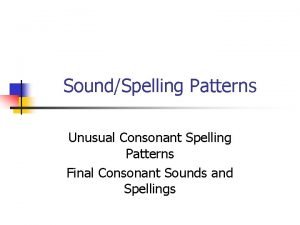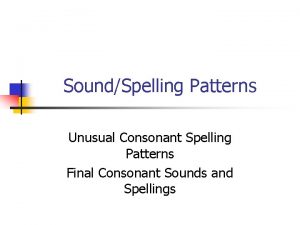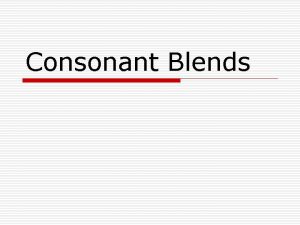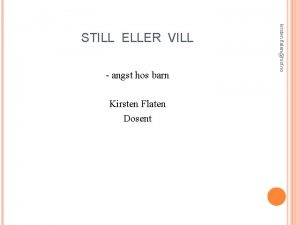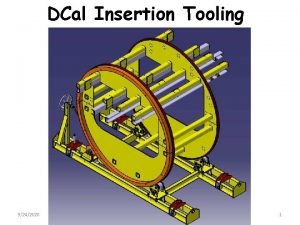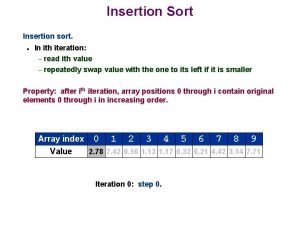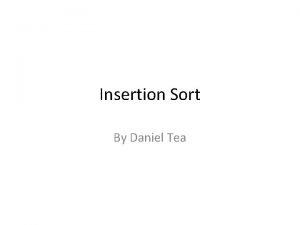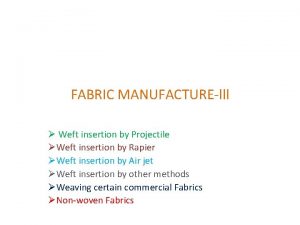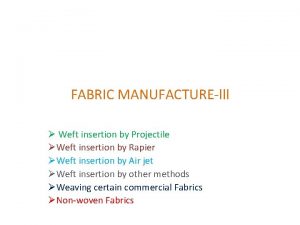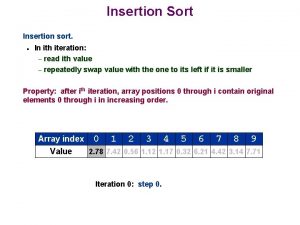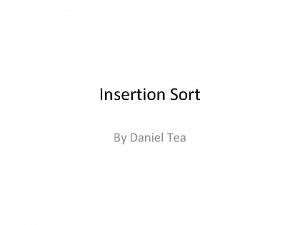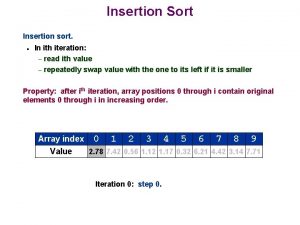AMFOAN CONSONANT INSERTION DIACHRONIC ORIGINS ENUS 7 Kirsten


































- Slides: 34

AMFO'AN CONSONANT INSERTION: DIACHRONIC ORIGINS ENUS 7 Kirsten Culhane The Australian National University

CONSONANT INSERTION IN AMFO'AN • Amfo'an attests processes of synchronic consonant insertion by which the segments /ʤ/ /ɡ(w)/ and /l/ are inserted after vowel final words in range of phonological and syntactic environments • Regular and predictable based on the preceding vowel: /ʤ/ is inserted after /i/, /l/ after /e/ and /ɡw/ after /o/ and /u/ • Consonants are inserted when a vowel final word is followed by a vowel initial enclitic 1) Ai + kee + kiu + =es =es → → → aiʤes keeles kiuɡwes ‘one fire’ ‘one turtle’ ‘one tamrind fruit’

CONSONANT INSERTION IN AMFO'AN • Consonants are inserted after vowel final words when they occur at the end of a noun phrase 2) Phrase-Medial Phrase-final ‘rope’ taniʤ ‘house’ umel ‘bird’ koloɡ ‘dog’ asuɡ • This presentation will demonstrate that the inserted segments are not a result of retention, but an innovation and demonstrate that the inserted segments are a result of regular sound change

PRESENTATION OUTLINE • Introduction • Overview of consonant insertion(s) in Amfo’an • Retention? • Innovation • Proposed account • Conclusions

INTRODUCTION Amfo’an is a variety of Meto: a cluster of closely related Austronesian languages and dialects spoken on the western part of the island of Timor. Figure 1: Self-identified varieties of Uab Meto (Edwards 2016)

INTRODUCTION Final consonant insertion is a distinctive feature of Amfo’an and is highly salient to speakers more than 14 different dialects of Amfo’an Dialects have distinct lexical and morphophonological differences All dialects demonstrate processes of consonant insertion The data in this presentation is from the Nai'Bais dialect of Amfo’an as spoken in the desa (villages) of Lelogama and Fatumonas

SYNCHRONIC CONSONANT INSERTION(S) IN AMFO'AN

INSERTION BEFORE VOWELINITIAL ENCLITICS • If a vowel-final clitic host is followed by a vowel-initial enclitic, consonant insertion occurs 3) fai + =es → faiʤes ‘one night’ noe + =es → noeles ‘one river’ meo + =es → meoɡwes ‘one cat’ hau + =es → hauɡwes ‘one tree’

INSERTION BEFORE VOWEL INITIAL ENCLITICS: NOUNS • If CV final, consonant inserted , host undergoes metathesis + vowel assimilation 4) fafi + =es → fafiʤes → C-insertion faifʤes Metathesis → faafʤes ‘one pig’ Vowel assimilation bale + =es → baales ‘one place’ neno + =es → neenɡwes ‘one day’ asu + =es → aasɡwes ‘one dog’

INSERTION BEFORE VOWEL INITIAL ENCLITICS: VERBS 5) n-kai + =en → n-kaiʤen ‘already harvested’ na-tae + =en → na-taelen ‘already answered’ n-nao + =en → n-naoɡwen ‘already went’ n-fani na-hine n-mepu + + + =en =en → → → n-faanʤen na-hiinlen n-meepɡwen ‘already returned’ ‘already know’ ‘already worked’

4) NOUN PHRASE FINAL CONSONANT INSERTION in n-mees 3 SG 3 -alone-M ‘s/he is alone at the house’ hai n-bi 3 -LOC anah a|n-toko n-bi 1 EX child 3 -sit 3 -LOC ‘our children sat in a round house’ ume-l house ume house bubuʔ round

NOUN MODIFICATION • No consonant insertion if nominal is NP medial 5) Noun + Modifier → Phrase Gloss sisi-ʤ + metoʔ → sisi metoʔ ‘dried meat’ biʤae-l + fui-ʤ → biʤae fui-ʤ ‘wild cow’ neno-ɡ + klei-ʤ → neno klei-ʤ asu-ɡ + anaʔ → asu anaʔ ‘church day’ (ie Sunday) ‘small dog’ ‘meat’ ‘cow’ ‘day’ ‘dog’ ‘dry’ ‘wild’ ‘church’ ‘small’

FUNCTIONS OF NP-FINAL CONSONANT INSERTION • Differentiates attributive phrases and equative clauses 6) Noun + Attribute [NP ume anaʔ ] [NP fafi anaʔ ] Equative clause ‘a small house’ [NP umel ] [NP anaʔ] ‘(the) house is small’ ‘a baby pig’ [NP fafiʤ ] [NP anaʔ] ‘(the) pig is small’ • Differentiates ordinal and cardinal numbers Ordinal number [NP neno meseʔ ] Cardinal number ‘first day’ (ie Monday) [NP nenoɡ] [NP meseʔ] ‘one day’

FUNCTIONS OF NP-FINAL CONSONANT INSERTION • Indicates there is a 3 SG object argument 7) au ʔ-lomi ‘I like’ au ʔ-lomiʤ ‘I like it’ in na-hine ‘s/he knows’ in na-hinel ‘s/he knows it’ in n-inu ‘s/he drinks’ in n-inuɡ ‘s/he drinks it’

SYNCHRONIC PRODUCTIVITY • Consonants inserted after loan words in phrase-final position 8) kofiʤ teel fotoɡ ‘coffee’ ‘tea’ ‘photo’ From Dutch koffie From Malay teh Ultimately from English otoɡ kuluɡ ‘car’ ‘teacher’ From Dutch auto From Malay guru photo

ABOUT /a/ • There are very few /a/ final nouns in Amfo'an which would trigger consonant insertion: of the 426 nouns in my dictionary, 2 are /a/ final 9) paha tafa ‘land’ ‘society’ • These items are districted in their usage: paha is almost always metathesised and tafa only occurs in ritual speech. 10) paah pinan paha pinan lit. ‘land below’, ‘world’ ‘Satan’

ABOUT /a/ • If the host of a vowel-initial enclitic is Ca final, no insertion occurs 11) paha na-tefa na-mnaha + =es + =en → → → paahes nateefen namnaahen ‘one land’ ‘already met’ ‘already hungry ’ • If the host of a vowel-initial enclitic is Va final, ɡw insertion occurs 12) na-bɡua na-tɡoa + =en +=en → → na-bɡuaɡwen na-tɡoaɡwen ‘already ɡathered’ ‘already filled’

NON- ‘MINIMAL’ CONSONANT INSERTION • Consonant insertion in Amfo’an is not phonetically natural • This raises questions about the source of the process • Non-minimal consonant insertion processes tend to be the result of multiple changes which render the phonological basis of the insertion unclear • Amfo’an is a case of this

RETENTION?

ARE THE CONSONANTS RETENTIONS? • In Austronesian there are many instances where word final consonants were retained in certain environments, resulting in a synchronic consonant/zero alternation Eg Samoan Intransitive inu taŋi mataʔu Transitive inu-mia taŋi-sia mataʔu-tia POc *inum *taŋis *matakut Gloss ‘drink’ ‘cry’ ‘fear’ • This is not a plausible analysis for Amfo’an: inserted consonants do not correspond to final consonants in Proto-Malayo-Polyesian POc from Blust and Trussel (ongoing), Samoan data from Crowley and Bowern (2010): 123

RETAINED CONSONANTS? • Although there are forms that look like the consonant is retained like *manuk and manuɡ- there is no correspondence between inserted consonants in Amfo’an and final consonants in Proto-Malayo-Polynesian • In Meto, PMP word-final consonants have typically been lost (Edwards 2016), with the exception of *s and *n PMP Amfo'an Gloss *salaq n-sana Be wrong *mamaq n-mama Chew betel *ənəm nee six *əpat haa four *inum n-inu drink PMP from Blust and Trussel (ongoing)

CONSONANT-FINAL FORMS IN PMP + AMFO'AN COGNATES Amfo'an Gloss Regular sound change 13) PMP > Meto *Rumaq umel ‘house’ *q > ø *zauq ʔlooɡ ‘far’ *kemiq miiʤ ‘urine’ *ma-putiq mutiʔ ‘white’ *babuy fafiʤ ‘pig’ *panjay anel ‘field rice’ *muntay mukeʔ ‘citrus’ *tasik tasiʤ ‘sea’ *k > i_V , *k > h /#_ *manuk manuɡ ‘chicken’ *k > ø elsewhere *y > ø PMP from Blust and Trussel (ongoing), PMP > Meto sound correspondences from Edwards (2016)

INNOVATION • Consonant insertion only occurs in Meto and not in Rote, and not in all varieties of Meto- indicating the process was not inherited • Corresponding forms of the enclitics that trigger consonant insertion Amfo’an demonstrate no consonant insertion in Rote: 14) Landu Gloss ani=a oe=a tane=a ‘the wind' ‘the water' ‘the mud’ keo=a ledo=a ‘the black' ‘the sun' Landu data from Owen Edwards, p. c May 2018

INNOVATION • Not all varieties of Meto attest consonant insertion before enclitics • For example, in Kualin (Southern Amanuban) vowel final clitic hosts are followed by vowel initial enclitics with no consonant inserted 15) Kualin Gloss fua=ee mii oa=ee kfeti=ee ‘the bean’ ‘the urine’ ‘the slingshot’ Kualin data from Owen Edwards, p. c May 2018

PROPOSED ACCOUNT

DIACHRONIC ORIGINS OF THE INSERTED SEGMENTS • /ʤ/ and /ɡ/ are not inherited; they do not correspond to any of the regular sound changes in Meto • /ʤ/ and /ɡ/ are phonologically restricted; /ɡ/ only occurs in the context of /o/ /u/, /ʤ/ only occurs in the context of /i/ • Apparent that these segments are a result of glide fortition

GLIDE EPENTHESIS + FORTITION • Apparent that /ʤ/ and /ɡ/ insertion is a result of epenthetic glides that underwent fortition • synchronic glide epenthesis attested in other varieties of Meto • For example, Amanuban: 17) ai + ee meo + ee hau + ee → → → Amanuban aijee meowee hauwee Amfo'an aiʤee meoɡwee hauɡwee ɡloss ‘the fire’ ‘the cat’ ‘the wood/tree’ Data from Owen Edwards, p. c February 2018

WORD-MEDIAL GLIDE FORTITION • /ʤ/ and /ɡ/ also attested word medially 16) Amfo'an nuɡa na-bgua biʤaas a|bʤaan a|fɡue-l a|pɡuah Other Meto nua na-bua PMP *duha Gloss ‘two’ ‘gather’ ‘usually’ (from Malay biasa) bian foe puah *buay *buaq ‘other’ ‘bean’ ‘betel nut’

DIACHRONIC SOURCES OF /l/ INSERTION • /l/ insertion is not a result of glide fortition- it is an inherited segment, resulting from *r > /l/ sound change • Amfo'an and its closest relatives (Fatule'u, Baikeno + Molo) attest insertion of /l/ after /e/ final words before vowel-initial enclitics • It is apparent that formerly, these varieties attested a process of /r/ insertion after vowel-final clitic hosts • This process is still attested in the Kusa-Manea variety of Meto

KUSA-MANEA CONSONANT INSERTION • /r/ insertion after /e/ and /a/ 18) ai + aa oe + aa bia + aa oo + aa → → aijaa oeraa biaraa ooaa ‘that fire’ ‘that water’ ‘that cow’ ‘that bamboo’ hau + aa → hauwaa ‘that tree’ Kusa-Manea data from Owen Edwards, p. c February 2018

WHERE DID /r/ INSERTION COME FROM? • No apparent phonological basis for /r/ insertion • no indication of where it came from • Kusa-Manea data limited- with current data, no further conclusions can be made

WHAT ABOUT /a/? • Very few /a/ final words- many historically /a/ final words underwent *a > /e/ sound change 19) PMP Amfo'an Gloss *Rumaq ume-l ‘house’ *ma-əsa mese ‘alone’ *ma hataq n-mate ‘raw’ *qa. Rta ate-l ‘slave’ ‘black person’ • It seems that there was so few /a/ final nominals that these forms became exceptions

IMPLICATIONS +CONCLUSIONS

CONCLUSIONS • Source of /ʤ/, /ɡ/ and /l/ insertion in Amfo'an can be accounted for diachronically • Consonant insertion in Amfo'an is an innovation: inserted consonants are not historical retentions • Inserted consonants are a result of regular sound change • Process comes from a former process of glide insertion after /i/ /o/ and /u/ and /r/ insertion after /e/ and /a/ • Lack of synchronic insertion after /a/ can be explained by lack of /a/ final forms; it seems there were so few /a/ final words that they became exceptions
 Boring superlatives
Boring superlatives Superlative de colorful
Superlative de colorful Microsoft aadp implementation
Microsoft aadp implementation Support zoom enus articles
Support zoom enus articles How does linguistics differ from traditional grammar
How does linguistics differ from traditional grammar Synchronic lexicology deals with
Synchronic lexicology deals with Descriptive lexicology
Descriptive lexicology μεταφραση7
μεταφραση7 Synchronic and diachronic approaches to polysemy
Synchronic and diachronic approaches to polysemy Synchrony and diachrony
Synchrony and diachrony What is linguistic
What is linguistic Historical changeability of semantic structure
Historical changeability of semantic structure Kirsten sandberg
Kirsten sandberg Kirsten carr
Kirsten carr Kirsten tollefson
Kirsten tollefson Hendrik kirsten
Hendrik kirsten Forløbsmodellen
Forløbsmodellen Kirsten pedd
Kirsten pedd Kirsten places her surveyor's telescope
Kirsten places her surveyor's telescope Kirsten heide
Kirsten heide Kirsten bunney
Kirsten bunney Kirsten hurley
Kirsten hurley Kirsten wismer
Kirsten wismer Kirsten elger
Kirsten elger Allison janowski
Allison janowski Kirsten lau baggesen
Kirsten lau baggesen Kirsten ohm kyvik
Kirsten ohm kyvik Chapter 5 lesson 1 origins of hindu india
Chapter 5 lesson 1 origins of hindu india What are your impressions of beowulf explain
What are your impressions of beowulf explain The origins of hospitality and tourism
The origins of hospitality and tourism The origins and spread of christianity
The origins and spread of christianity Origins of american government section 1
Origins of american government section 1 Vikings land
Vikings land Origins of american government section 1
Origins of american government section 1 Hip thigh and leg muscles
Hip thigh and leg muscles
